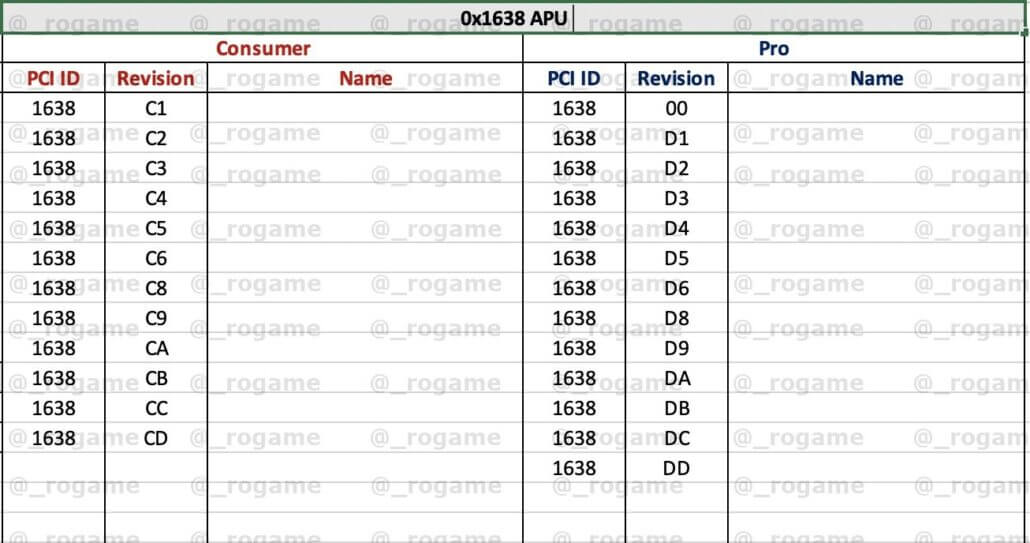AMD’s next-generation Ryzen 5000 APUs codenamed as “Cezanne” have once again been spotted, but this time with proper device IDs for these chips. AMD Cezanne APUs will fall under the 1638 Device ID and several PCI IDs have been spotted by _Rogame, coming via Komachi.
The current Renoir ‘Ryzen 4000’ APU family is based on the Zen 2 CPU and Vega GPU architecture. The CPU is fabbed on the 7nm process node. The Ryzen 5000 Cezanne APU lineup will be a direct successor to Renoir. These are rumored to be based on the ZEN 3 architecture, having VEGA GPU cores. These might target the high-end notebook (FP6), and mid-range desktop APU segment (AM4 socket).
The Cezanne family will be based on two segments, the high-performance Cezanne-H and the low-power Cezanne-U series. These processors will be based on the FP6/AM4 package, the BGA platform. The GPU powering the Cezanne APU is going to be an ‘enhanced’ version of the existing Vega/GCN architecture silicon. The Cezanne APUs should be fabbed on the TSMC’s N7 process node, but we don’t know for sure. These are expected to hit the market by 2021.
AMD’s Renoir family uses the 1636 PCI ID while the custom low-powered Van Gogh line of APUs are going to use the 163F PCI ID. According to Komachi, Cezanne APU is still going to be based on the GFX9 architecture. So we are once again going to see an enhanced version of Vega on the next-generation of APUs. As per speculation the upcoming Cezanne APUs will feature a brand new CPU core just like Renoir APUs. These APUs will retain the AM4 socket till 2021, so we can expect AMD to upgrade to AM5 around 2022 timeframe.
These are APUs, and unlike normal desktop CPUs, these have integrated onboard Graphics (not comparing here with Intel’s iGPU though). Simply put, an APU is constituted of both the CPU and GPU cores on a single die. They often serve as an approachable entry-level graphics solution for budget gaming PCs and gaming laptops alike.
Those gamers who don’t want a dedicated/discrete GPU can go for an APU setup for “casual” light Gaming. Until now AMD has only released budget APUs, with the assumption that serious gamers and professionals will mostly go for a discrete graphics cards in their systems, which seems to be a reasonable assumption if you ask me. But with the new Renoir APU lineup things have been a bit different.
An APU can also be seen as a ‘backup’ option, just in case your GPU dies. Or, these could alternatively be used in NAS boxes, servers, media centers etc. Rumor has it that these new APUs will use the same Vega architecture as the Ryzen 4000 Mobile chips. This seems like a slight bummer since NAVI APU would have been an interesting option, in my opinion. The GE SKU APUs on the other hand might be an ideal option for compact gaming PCs which require high core counts along with low levels of power consumption/heat, at 35 Watts TDP. AMD can also target pre-built and OEM PCs, with the Vega integrated Graphics.
Hello, my name is NICK Richardson. I’m an avid PC and tech fan since the good old days of RIVA TNT2, and 3DFX interactive “Voodoo” gaming cards. I love playing mostly First-person shooters, and I’m a die-hard fan of this FPS genre, since the good ‘old Doom and Wolfenstein days.
MUSIC has always been my passion/roots, but I started gaming “casually” when I was young on Nvidia’s GeForce3 series of cards. I’m by no means an avid or a hardcore gamer though, but I just love stuff related to the PC, Games, and technology in general. I’ve been involved with many indie Metal bands worldwide, and have helped them promote their albums in record labels. I’m a very broad-minded down to earth guy. MUSIC is my inner expression, and soul.
Contact: Email


